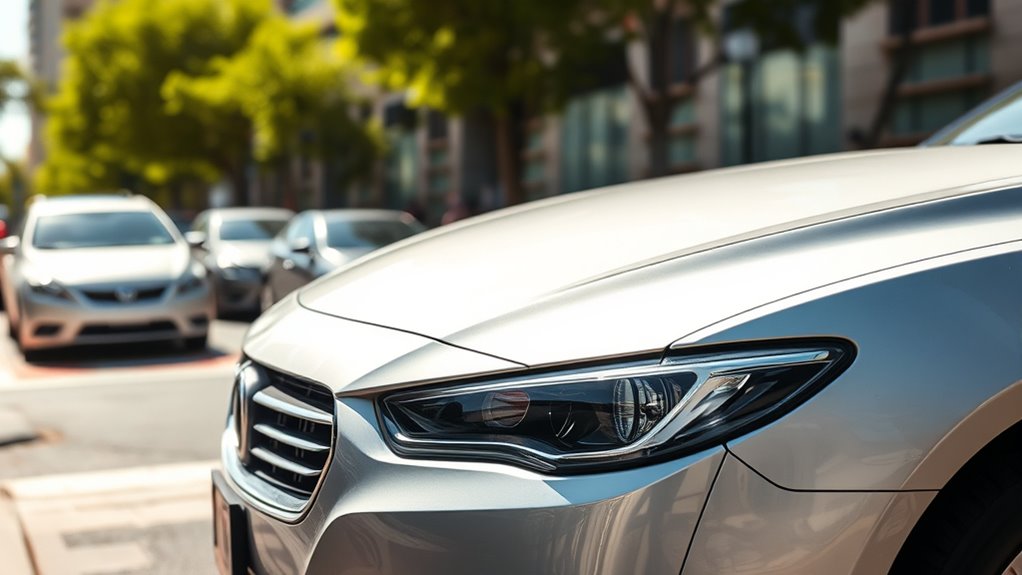Car depreciation directly affects your ownership costs by reducing the vehicle’s value over time, which impacts your resale price and trade-in value. Faster depreciation means higher leasing payments and can keep insurance premiums higher longer. It also influences how much you’ll recover if you sell or trade the car later. Understanding how depreciation works helps you choose better vehicles and manage costs more effectively. Keep exploring to see how you can make smarter car ownership decisions.
Key Takeaways
- Rapid depreciation increases leasing payments by reflecting faster loss in vehicle value.
- Faster vehicle value decline keeps insurance premiums higher for new or expensive cars.
- Higher depreciation reduces resale value, increasing total ownership costs over time.
- Understanding depreciation helps optimize ownership duration and choose vehicles with slower value loss.
- Recognizing depreciation’s impact enables better financial planning for trade-ins and long-term costs.

Have you ever wondered how much your car loses in value each year? It’s a common question, especially when you’re trying to budget for ownership costs. Car depreciation isn’t just about the sticker price dropping; it influences your overall expenses in ways you might not immediately realize. One of the key ways depreciation impacts you is through leasing costs if you’re considering leasing rather than buying. When you lease a vehicle, the leasing company factors in the expected depreciation over the lease term to determine your monthly payments. Essentially, they’re covering the loss in value the car will experience while you’re using it. As a result, a car that depreciates faster will typically lead to higher leasing costs because the leasing company needs to recoup that depreciation.
Depreciation increases leasing costs and impacts your vehicle’s overall ownership expenses.
Beyond leasing, depreciation also affects your insurance premiums. Insurance companies often base their rates on the current value of your vehicle, which declines as your car ages. The lower the car’s value, the less it costs to replace or repair, and consequently, the insurance premiums tend to decrease over time. However, when a new or expensive car depreciates rapidly, your initial insurance premiums might be higher because the vehicle’s replacement cost is greater. If your car depreciates faster than average, you might notice that insurance premiums stay higher for longer or fluctuate more because the insurer is balancing the risk of total loss against the car’s declining value.
Understanding depreciation also helps you grasp how ownership costs add up over time. When you buy a new car, the biggest hit comes from depreciation in the first few years, sometimes losing as much as 20-30% of its value in the first year alone. This decline impacts resale value, which is a vital factor if you plan to sell or trade-in your vehicle later. The quicker your car depreciates, the less you’ll get back when you sell it, making the total cost of ownership higher than just the monthly payments and insurance premiums. Additionally, knowing how quickly your car’s value drops can help you choose the right vehicle and ownership duration to maximize your investment.
Knowing how depreciation influences leasing costs and insurance premiums allows you to make smarter choices. If minimizing ownership costs is your goal, you might lean toward vehicles that depreciate more gradually, or carefully consider whether leasing or buying makes more financial sense for your situation. Being aware of how quickly your car’s value drops can also guide your decision on how long to keep it, helping you avoid the trap of owning a vehicle that’s worth much less than what you paid for it. In the end, understanding depreciation helps you see the full picture of what owning a car truly costs beyond just the sticker price or monthly payments.
Frequently Asked Questions
How Does Depreciation Impact Long-Term Vehicle Affordability?
Depreciation directly impacts your long-term vehicle affordability by lowering its resale value over time. As your car depreciates, you’ll likely face higher maintenance expenses to keep it running smoothly. This means you’ll need to budget more for repairs and upgrades, which reduces your overall savings. Understanding depreciation helps you choose vehicles with better resale value, ultimately making ownership more affordable in the long run.
Are Luxury Cars More Affected by Depreciation Than Economy Models?
Like a knight’s armor in a modern fairytale, luxury cars are more affected by depreciation than economy models. You lose more value over time because of luxury premiums and brand value, which quickly diminish. While they start with higher prices, their depreciation hits harder, making them less cost-effective long-term. So, if you’re eyeing a luxury ride, expect sharper value drops, especially compared to more budget-friendly options.
Can Depreciation Rates Vary by Geographic Region or Market?
Yes, depreciation rates can vary by geographic region or market. You’ll notice regional pricing differences and market fluctuations influence how quickly a car loses value. In areas with high demand or limited supply, depreciation tends to be slower, while markets experiencing economic shifts or changing preferences see faster depreciation. Keep in mind, regional factors like local taxes and infrastructure also impact a vehicle’s resale value over time.
How Do Lease Options Influence Depreciation-Related Costs?
Lease options influence depreciation-related costs through lease incentives, which can lower your monthly payments, and the residual value, which determines how much the car is worth at lease end. A higher residual value means less depreciation expense, reducing costs for the lessor and potentially benefiting you with lower lease payments. Understanding these factors helps you evaluate how depreciation impacts your overall lease costs and choose the best leasing option.
What Are Effective Strategies to Minimize Depreciation Losses?
Want to keep more of your car’s value? Focus on boosting your trade-in value by maintaining regular service, keeping it clean, and avoiding accidents. Resale strategies like selling privately can often yield higher returns than trading in. Timing matters too—sell before depreciation hits its peak. Stay ahead of market trends and consider investing in popular features; these tips help minimize depreciation losses and maximize your resale potential.
Conclusion
Understanding how car depreciation impacts ownership costs helps you make smarter choices. While a new car might seem appealing, its rapid depreciation can drain your wallet faster than you expect. On the other hand, a well-maintained used car may cost less upfront and hold its value longer. So, as you weigh your options, remember: sometimes, what’s lost in depreciation is gained in long-term savings—showing that smart choices today shape your financial future tomorrow.









